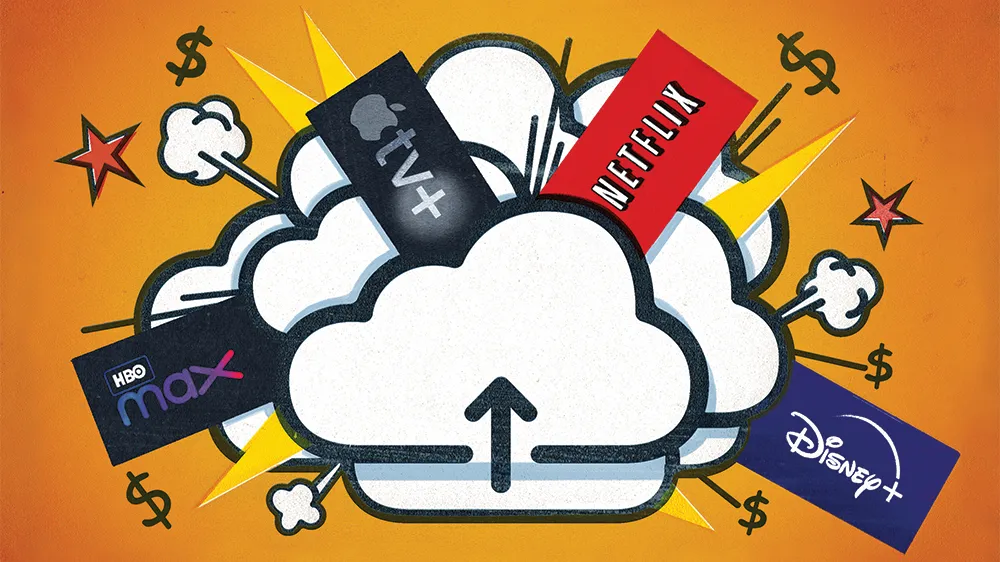Streaming services have become a cornerstone of modern entertainment, and major industry players such as Disney, Netflix, Paramount, NBCUniversal, and Warner Bros. Discovery are orchestrating a significant shift. The focus is increasingly shifting towards enticing subscribers to explore ad-supported tiers, marking a transformative phase in the dynamics of the streaming landscape.
Table of Contents
Disney’s Strategic Shift
Disney’s recent strategic shift in the realm of streaming marks a critical juncture for the entertainment giant. CEO Bob Iger’s announcement of substantial price increases for Disney+ and Hulu’s ad-free tiers unveiled a bold move. A move that would turn the money-losing streaming business into a profitable venture.
Notably, the pivot also underscored a commitment to accessibility, with pricing for standalone ad-supported Disney+ and Hulu offerings remaining unchanged. This dual-pronged approach reflects Disney’s astute understanding of the evolving streaming landscape, where profitability and inclusivity are delicately balanced.
As Disney navigates the complexities of the streaming industry, this strategic shift demonstrates a nuanced response to the economic realities of the market, positioning the company to capture a broader audience while pursuing financial viability in the competitive world of streaming services.
Industry-Wide Pricing Changes
The landscape of streaming services is undergoing a seismic shift, with industry-wide pricing changes implemented by major players like NBCUniversal, Paramount+, and Netflix. NBCUniversal raised the stakes by increasing Peacock’s ad tier by $1 per month, a strategic move in tune with the broader industry trend.
Paramount+ opted for a bold maneuver by discontinuing its $9.99 ad-free tier in favor of an $11.99 tier that includes Showtime content, subtly making the ad-supported option more appealing. Even Netflix, without raising overall prices, made a subtle yet impactful move by discontinuing its $10-per-month “Basic” plan, redirecting new subscribers towards the more affordable $6.99-per-month ad tier.
These synchronized pricing adjustments across major platforms underscore a collective effort to make ad-supported tiers more attractive to consumers, signaling a dynamic shift in the industry’s pricing strategies and a strategic response to the evolving demands of the streaming audience.

Consumer Behavior and Ad-Supported Tiers
Consumer behavior is shaping the streaming landscape, prompting major shifts towards ad-supported tiers. Economic pressures have made it challenging for viewers to juggle multiple streaming subscriptions, leading services like Disney+ and Netflix to strategically offer more accessible, ad-supported options.
This shift is not merely a response to financial constraints; it reflects a deliberate effort to cater to the evolving mindset of viewers. Early indicators from Disney+ reveal that 40% of new subscribers opt for the ad-supported tier, showcasing a clear preference among consumers.
The strategic alignment of pricing structures with consumer behavior suggests that viewers are increasingly valuing the cost-effectiveness of ad-supported plans, emphasizing the pivotal role these tiers play in the streaming industry’s quest for profitability and audience retention.
As platforms adapt to consumer realities, the prominence of ad-supported tiers highlights a nuanced understanding of the economic constraints and preferences shaping today’s streaming landscape.
Revenue Dynamics
Streaming giants are witnessing a profound shift in revenue dynamics, with a strategic emphasis on ad-supported plans. Executives from Disney, Netflix, Paramount, Warner Bros. Discovery, and NBCUniversal have observed that total revenue per user is notably higher on ad-supported plans compared to their ad-free counterparts.
This surprising insight has spurred a collective industry push towards encouraging subscribers to opt for more economically rewarding ad-supported tiers. The growth in ad-supported user bases, like Netflix doubling its numbers since the first quarter, underscores the financial viability of this model.
As streaming companies find themselves drawn to the better margins offered by ad-supported plans, the industry is witnessing a fundamental transformation in how revenue is generated. The shift in focus from ad-free to ad-supported tiers highlights a strategic response to economic realities and positions streaming platforms for sustained financial success in an increasingly competitive market.
Streaming Services
Advertising on streaming services has become a pivotal element in the industry’s evolution, shaping the future of content access. Streaming platforms, such as Disney, Netflix, Paramount, Warner Bros. Discovery, and NBCUniversal, are strategically creating a clearer choice for consumers between ad-supported and ad-free offerings.
The integration of advertisements with quality content is seen as a logical next step. Early indicators include 40% of new Disney+ subscribers choosing the ad-supported tier. This suggests that consumers not only tolerate but increasingly value advertising in video content.
This shift aligns with the economic pressures faced by consumers. It provides them with lower-cost options and, when done right, enhancing the overall viewing experience. As streaming services navigate this delicate balance, advertising emerges as a crucial lever. They drive sustained profitability and audience engagement in the evolving landscape of digital content consumption.
Future Outlook
The future outlook for the streaming industry is shaped by a dynamic landscape. It is marked by positive reports in the TV upfront market. Streaming advertising and live sports stand as resilient pillars amidst a challenging advertising environment.
Companies like Disney, Paramount, and NBCUniversal report increased commitments to their streaming properties. This highlights the growing significance of ad-supported streaming in the pursuit of profitability. As advertisers seek high-quality content environments, streaming services are aggregating larger audiences with personalized content. So, ad experiences are becoming increasingly attractive.
Despite the historical strength of subscription-based models, the ad-supported streaming business is evolving. It is providing consumers with more options and platforms with additional levers to achieve profitability.
David Cohen, CEO of the Interactive Advertising Bureau, asserts that this evolving dynamic challenges the historically stronger profit margins of subscription-video-on-demand platforms. He emphasized the growing role of ad-supported streaming in shaping the industry’s future landscape.

Impact of Ads on Prime Video and Netflix
The imminent introduction of ads in Prime Video by Amazon signifies a transformative juncture in the streaming landscape. This move raises fundamental questions about the essence of streaming services. This is because platforms that offer an ad-free experience now incorporate advertising.
For Netflix, renowned for its ad-free tiers, the evolving streaming landscape presents challenges as monthly fees increase industry-wide.
As the industry adapts, the potential impact on viewing experiences becomes a focal point. Netflix and Amazon’s strategies could influence not just their financial strategies but also their creative and viewing dynamics. This poses implications for the future of streaming services and consumer engagement.
A La Carte Subscriptions
The concept of a la carte subscriptions is a game-changer, allowing viewers the freedom to curate their entertainment experience. Unlike traditional bundled cable subscriptions, a la carte subscriptions empower consumers to choose only the services they desire. This eliminates the need for unnecessary channels or content.
This model not only provides cost-effectiveness but also aligns with the modern viewer’s desire for personalized, on-demand content. The freedom to select specific streaming platforms based on individual preferences enhances the overall streaming experience.
It reflects a shift towards more consumer-centric models in the ever-evolving landscape of digital entertainment. This approach ensures viewers have control over their content choices. It heralds a new era in how audiences access and consume entertainment.
Beyond Ad-Free
The streaming industry, once synonymous with ad-free content, is undergoing a metamorphosis. Pricing changes, the rise of ad-supported tiers, and the introduction of ads in premium services signal a shift towards a new era. While challenges and concerns loom, streaming services are adapting their financial strategies to balance the books and explore new avenues for profitability.
As we navigate this evolving landscape, the future of streaming seems intertwined with the delicate balance between viewer preferences, economic realities, and the ever-growing influence of advertisements. The golden age of ad-free streaming might be evolving, but how streaming services adapt to these changes will shape the future of our digital entertainment experience.
Which streaming services are you using? Talk to us in the comments below!
For more similar blogs, visit EvolveDash today!
FAQs
- How do ad-supported tiers impact the quality of content on streaming platforms?
Streaming services must balance ad revenue with content investment. While ads help generate revenue, the fear is that an increased focus on ad-supported models might affect the quality and quantity of original content. However, companies claim ad revenue allows for more sustainable content creation.
- Do ad-supported streaming tiers show the same content as ad-free plans?
In most cases, the content remains the same across both ad-supported and ad-free plans. However, some premium content, such as early access to new releases or certain high-budget originals, may be exclusive to ad-free tiers.
- Will bundling services become more common with the shift to ad-supported plans?
As the industry shifts, more streaming services are considering bundled offerings, similar to cable packages. Companies like Disney are already offering combined Disney+, Hulu, and ESPN+ packages, and other providers may follow suit.
- Are there any privacy concerns with ad-supported streaming plans?
Ad-supported plans often rely on data collection to target ads based on viewer preferences. This raises concerns about privacy and data tracking, as users may have less control over how their viewing habits are used for ad targeting.
- How does the push for ad-supported streaming impact traditional cable TV?
As streaming platforms introduce more ad-supported tiers, traditional cable TV faces increased competition. Many consumers are now weighing the cost of streaming with ads versus paying for traditional cable services, leading to a shift in how audiences consume content.



















